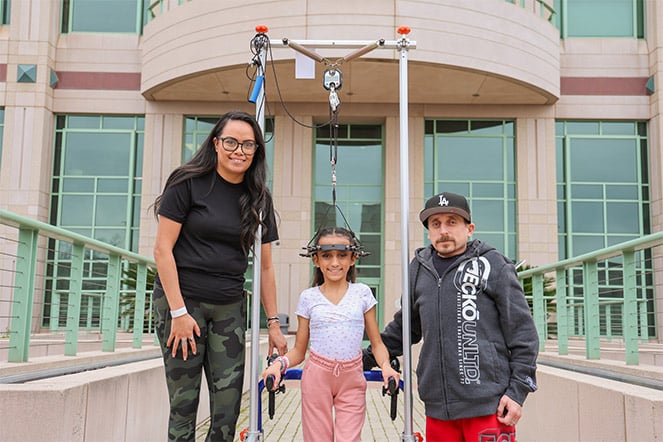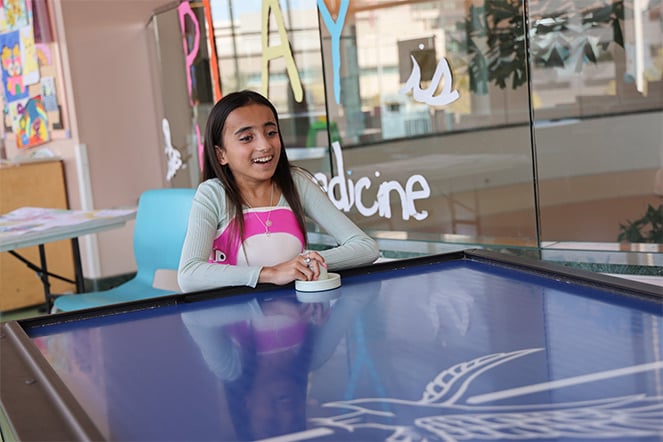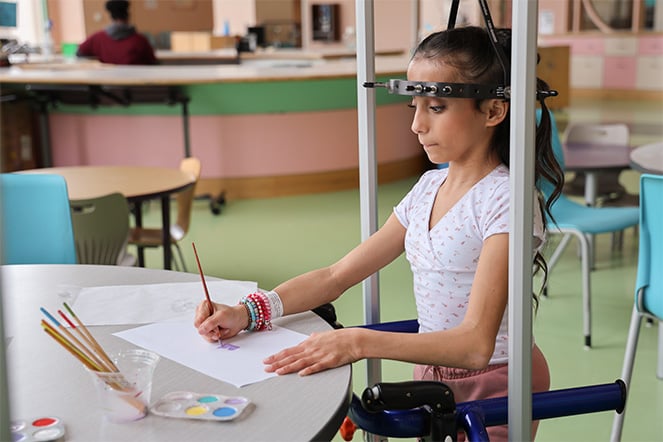OI Expertise at Shriners Children’s Northern California
Anakalia, who recently turned 13, has been receiving treatment from Shriners Children’s Northern California since she was a baby. “Most providers in our area don’t know how to treat OI,” said Krystine. “They wrap her up and send us to Shriners Children’s.”
Given the nature of her condition, Anakalia is prone to frequent bone fractures. Four years ago, she underwent surgery with Debra Templeton, M.D., to get rods placed in her legs. These rods assist with both strength and stability. “I haven’t broken a bone in my legs since I got the surgery,” Anakalia said.
When Anakalia fractures something, she and her parents have a well-organized system for getting her treatment. They quickly wrap up the affected area and drive her to the local hospital in Redding. There, she is then placed in a splint before being transferred to Shriners Children’s Northern California for surgery. After about a month in a cast, she is done until the next fracture occurs. “It kinda hurts, but I’m kinda used to it by now,” she said. “It’s not as bad after a while.”
Along with having fragile bones, Anakalia’s spine has also been affected. Spinal deformities are known to occur in anywhere between 39% to 78% of all patients with OI.
For Anakalia and other patients with spine and spinal cord issues, Shriners Children’s Northern California has a robust spine and spinal cord program that has been able to treat them. Led by a team of highly skilled orthopedic surgeons, the program offers comprehensive care tailored to each child's unique needs. From scoliosis and kyphosis, to spinal cord injuries and congenital deformities, every aspect of treatment is approached with compassion, innovation and a commitment to maximizing function and quality of life.
Straightening Out With Halo
Prior to her halo traction treatment, Anakalia had an 87° curvature in her spine, with a slight twist. To put this in perspective, any spinal curve exceeding 60° is classified as severe. This curvature made it difficult for her to maintain proper posture while sitting and standing, and if left unaddressed, it could lead to further complications in the future. Chief of Staff Rolando Roberto, M.D., recommended that she undergo halo traction to assist in straightening her spine.
Halo traction is typically a first step in correcting severe scoliosis, kyphosis and other spine deformities. Patients remain in the hospital the entire time they are in traction, typically three to eight weeks. Usually after halo traction, patients have spinal fusion surgery to permanently stabilize the spine. Halo traction reduces the risk of damaging the nerves or soft tissues that surround and support the spine during surgery.
During surgery, an orthopedic surgeon attaches a lightweight metal ring (halo) to the patient’s skull with small pins. Once the halo is in place, it is attached to a pulley system, which is on the patient’s bed, wheelchair and walker. During the following several weeks, weight is added to the pulley to slowly straighten the spine.
Even though the surgery was a significant decision, Anakalia and her family were confident it was the best option and felt adequately prepared. Given the unique curvature and twist in Anakalia's spine, there was a realization that achieving a complete correction might not be feasible. However, this did not deter them, as they understood that any degree of improvement would be a step forward from her previous condition.
“I was actually excited to get the halo,” Anakalia said. “I was excited to straighten out and be taller.”
After the initial surgery to get the halo on, she said the first day was the worst of it. It was a bit of an adjustment at first: learning how to do her hair, adjusting the pulley and finding a comfortable sleeping position. After the first week, the whole family got into a routine and it was seamless from there.
For four weeks, Anakalia walked around Shriners Children’s Northern California with her halo. She decorated her room, played games in the GUM Pavilion and socialized with other patients. Within the first week, she said there was already a noticeable difference in her posture. By the last week, the change was incredible, and she was ready to have the halo taken off. She went into surgery extremely excited.





